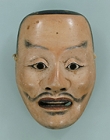Japanese Gallery (Honkan) Room 9
May 26, 2009 (Tue) - July 20, 2009 (Mon)
Kanehira is a play about Heian period warlord Kiso Yoshinaka and his retainer Imai Kanehira, the story of which goes as follows.
A monk on a journey from Kiso in Shinano province (present-day Nagano prefecture) to Awazu in Omi province (present-day Shiga prefecture) reaches at last the Yabase shore of Lake Biwa, where he meets an old man who appears from out of nowhere in a row boat, to whom the monk asks for a ride over to Awazu. Once they arrive at Awazu, however, the old man disappears, leaving the monk puzzled. The monk talks about his experience to a boatman nearby, who tells him that long ago, Kiso Yoshinaka and Imai Kanehira were cornered at this shore by their enemies and were driven to a tragic death. As the monk begins to pray, Kanehira's ghost appears as a warrior in arms, uttering the scene of his defeat in vivid verse: "The torturous pain of shining blades shattering the bones breaks through the eyes, the blood flows over the shield to color it over, leaving splatters like flower petals on the arrow case..." The ghost continues the old man was himself, and telling of his lord Kiso Yoshinaka's death and asking the monk to pray and pacify the spirit of his lord. After ending the dreadful tale with the scene of his own suicide, Kanehira's ghost vanishes.
On stage, rule has it that the costume of the monk should consist of sumieboshi, a hat with a pointed top, and mizugoromo, a robe made from thin fabric. The ghost of Kanehira, instead of wearing armor, should appear in a happi robe made from gold brocades along with hangire trousers - an elegant outfit befitting the Noh stage. This character also wears the Heita mask, which depicts the features of a warrior sun-tanned from many battles.
Noh plays based on stories of warriors defeated in battle are known as "Makeshuramono." This category is unique to Noh, which characteristically mourns the dead. Makeshuramono plays were generally avoided by the daimyo warrior class of the Edo period, yet Kanehira numbers among the masterworks that convey the aesthetics of the vanquished.

